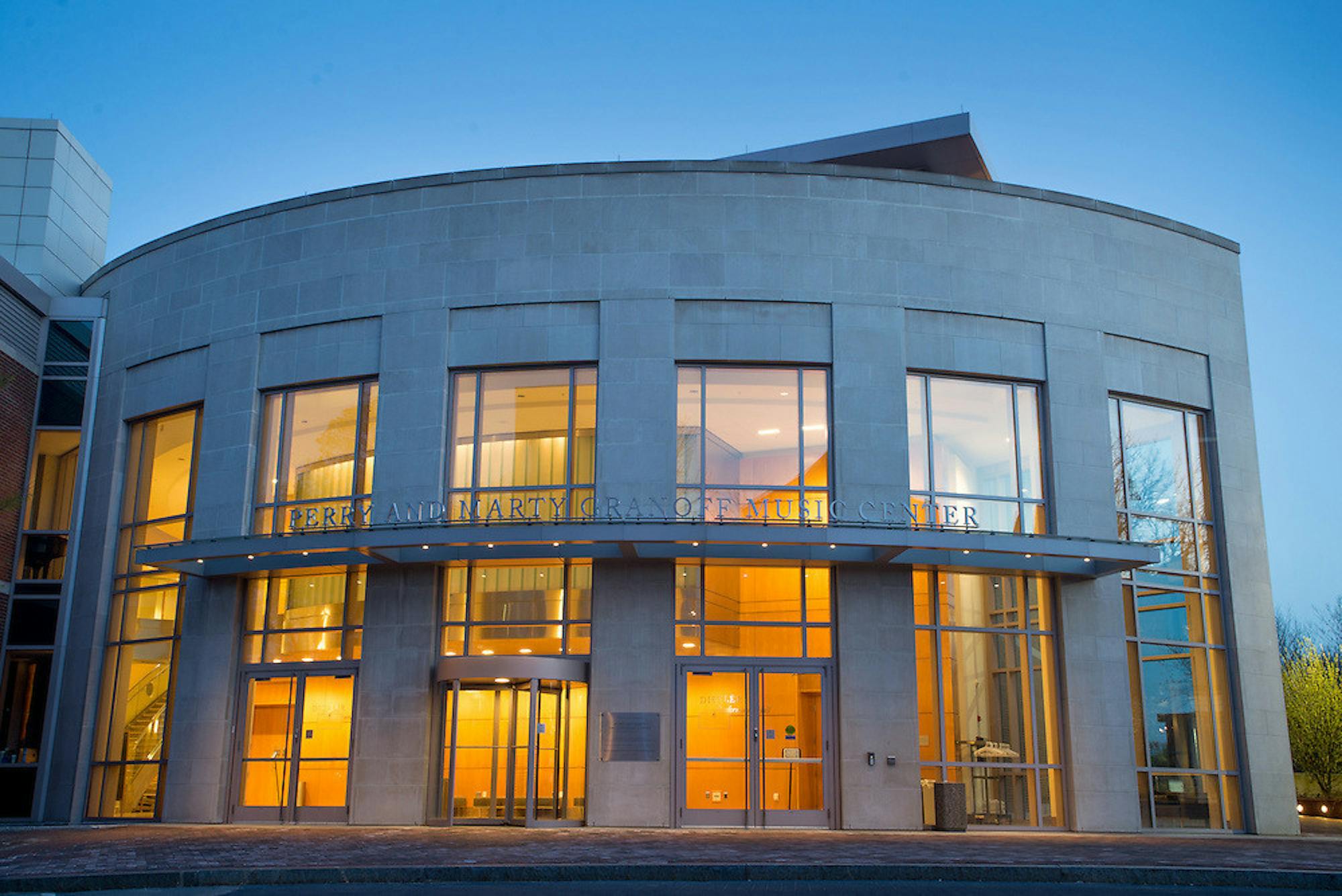The doors of Distler Performance Hall opened for the Tufts x NEC Dual Degree recital at 8:00 p.m. on March 7. Silence fell over the crowd as Lila Searls, a first-year in the dual degree program, and Lexie Aguilar, a first-year at the New England Conservatory (NEC), took the stage, both wielding soprano saxophones. The duo performed Christian Lauba’s composition “‘Ars for two soprano saxophones” (1994).
Initially intertwining and syncopated melodies created a complex texture and driving feeling, though as the song progressed, it delved into dissonance and rhythmic abstraction. The piece featured multiphonics, with both musicians playing multiple notes simultaneously. The technique made clear the title’s meaning, as the growling of the multiphonics resulted in an “ar” sound. The dissonances and multiphonics marked the piece becoming less tied to rhythmic structure, and it seemed as if it was deconstructing before the audience. The composition soon reversed trajectory, launching into a more articulated and rhythmic section. Eventually, the multiphonic elements reemerged, and the piece plunged back into dissonance. This section carried the composition to its end, concluding with one last multiphonic.
Next was Dan Cetlin, a fourth-year student in the dual degree program. After setting up his looper pedal, he began the first song of his set, which started with an alternating pattern of plucked and bowed chords on his violin. Cetlin inputted the sample into the looper pedal and added more layers. First a simple single-line melody was added, followed by another similar melody. The effect of the layers was that of a full string quartet. Cetlin soon began improvising over the loop. He swayed back and forth, eyes closed as new melodies soared out of his violin. The piece crescendoed, utilizing increasingly higher notes, until suddenly all sound ceased.
Cetlin transitioned into a new section, introducing a plucked line that set a steady rhythmic foundation. He added a percussive layer, pressing the bow against the strings to make a slapping sound. Cetlin improvised passionately over the new loop. Soon the loop dropped out, leaving only Cetlin soloing on his violin. A single note ended the piece, which Cetlin used a pedal to pitch downwards until it faded out entirely. Cetlin then introduced the song as an original titled “This Light of Mine.”
Following thunderous applause, he agreed to play another song. The second song, “Matilda,” followed a similar arc to the first, and techniques like plucked lines and percussive sounds reappeared. Cetlin improvised over the loops, employing fast syncopated lines. A long cadenza ended the piece.
Last was the jazz quintet “FakeArt,” led by drummer Nico Daglio Fine, a first-year in the dual degree program. The group featured Aaron Kaufman-Levine on alto saxophone, Garrett Frees on tenor saxophone, Jonathan Paik on piano and Leo Weisskoff on bass, all of whom are first-years at NEC. Their first song, “For Quintet,” began with a rubato solo from Kaufman-Levine. Weisskoff and Paik joined, creating an underlying rumbling texture, accented by Daglio Fine hitting his cymbals.
The texture gradually transitioned into a steady groove. After a piano interlude, Kaufman-Levine switched to soprano saxophone and catapulted into an electrifying solo. Frees joined him for the melody. Eventually the rhythm section dropped out and the saxophones entered a droning, dissonant section. One by one the rhythm section reentered, and the quintet flowed into its next song, a composition by Daglio Fine called “Twice Removed.” The song featured mesmerizing solos by Frees and Paik, and ended with a rubato solo by Kaufman-Levine, mirroring the beginning of the medley.
Daglio Fine told the audience that “For Quintet” was created using Chirp, an Artificial Intelligence program which had analyzed Anthony Braxton solos to write the song. Their next song; “Rice Type Beat,” was based on Chirp’s analysis of Sam Rivers’ solo on “Beatrice” (1965). It was a laid-back waltz, which began with both saxophones playing in harmony. During Paik’s solo the drums dropped out, eventually reintroducing themselves with sparse cymbal hits before transitioning fully into the groove.
When it was Kaufman-Levine’s turn to solo, Daglio Fine switched to a hand-drumming technique. FakeArt’s final song was a composition by Kaufman-Levine entitled “Dyslexic Dog.” A bluesy bass solo by Weisskoff kicked things off, and the asymmetrical meter created an unhinged, limping feeling. The saxophones entered, playing intertwining, eccentric melodies, leading into a tenor solo by Frees. As he ventured into higher registers he raised himself higher on his toes, almost threatening to leave the stage altogether. Frees’ energetic solo was followed by a piano solo, characterized by wild arpeggios that traversed the entire instrument. Kaufman-Levine contributed a similarly aggressive and abstract solo. A restatement of the melody ended the set. As FakeArt took a bow they were met with roaring applause, and the recital had reached its conclusion.
Tufts x NEC Dual Degree students present captivating recital

Granoff Music Center is pictured on May 7, 2014.





